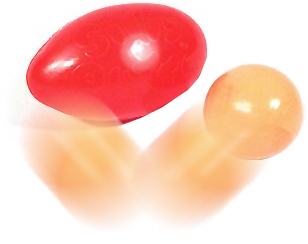
I would like to salute one of the best toys I ever received as a Christmas present: Silly Putty. Silly Putty is almost a senior citizen. The bouncing goo
ball that comes in an egg turned 60 years old this year. Silly Putty was not
designed as a toy. During WWII, scientists working for GE were trying to come
up with a synthetic rubber to compensate for a shortage in tires. They invented
a substance that was pliable and bounced. It also pulled ink from a newspaper
onto its surface. It was a failure as a tire, but it has done wonders as a toy.
To date, there have been over 300 million eggs of Silly Putty sold.
So how did a failed idea for rubber tires end up being such
a great idea as a toy? Like so many good ideas, it can be boiled down to one
person who had a vision and a great marketing plan. After WWII, GE tried to
come up with a use for the bouncing synthetic putty. They sent samples out to
the best and brightest scientists and engineers around the world to see if they
had any use for the product. No one submitted any ideas. During this time, a
toy shop owner in New Haven, CT, Ruth Fallgatter got a hold of the bouncing
putty. She contacted her marketing consultant, Peter Hodgson, who was putting
together a catalog for Fallgatter’s store. He added the product in the catalog
and the putty sold very well. Hodgson thought he could take the little ball of
goo nationwide. Hodgson bought the production rights from GE. He packaged one
ounce balls of the product in a plastic egg and named it Silly Putty. He set up
shop in a barn, found a local poultry co-op who supplied him with egg cartons
for the packaging of his Silly Putty eggs. Hodgson took Silly Putty to the
International Toy Fair in New York City in February 1950. All of the toy
marketers he spoke with told him to give up. They saw no future for a
dough-filled egg. But he saw potential in the product and tried a different
approach. He talked his product onto the shelves of Doubleday Book Stores.
Later that summer, a New Yorker magazine writer purchased Silly Putty while
perusing a Doubleday store. He wrote about the product in August and within
three days, Hodgson had over 750,000 orders!
Oddly enough, Silly Putty was being sold as an adult novelty
item by retail outlets. Hodgson knew that the real potential for Silly Putty
was not with adults. Adult toys have a very short lifespan. He saw the real
potential for his product with children. This is where Hodgson made a strategic
marketing move. He decided to use a new medium for advertising directly to
children: television. He was one of the first marketers to target his audience
via children’s shows (The Howdy Doody Show and Captain Kangaroo.) He produced a
very simple 60 second spot that helped tip the scales for sales to children. By
1957, 80% of Silly Putty sales were to children age 6-12. His vision and keen
marketing instincts paid off. Silly Putty’s brand appeal was being experienced
globally. In 1961, hundreds of people stood in line at the Silly Putty display
at the U.S. Plastics Expo in the Soviet Union. That same year, Silly Putty took
Europe by storm. In 1968, it was included with the Apollo 8 mission to the
moon. A classic egg of Silly Putty is on display at the Smithsonian Institute
and The National Toy Hall of Fame.
So what is the lesson we can learn from Silly Putty? For
one, launching a new product takes a vision of what can be that defies previous
assumptions. Peter Hodgson envisioned Silly Putty’s potential, but he had to
look past what the scientists at GE, with all of their research and corporate
influence, had failed to see. This was not an industrial product, it was a
child’s toy. Any new product has to cast off old thinking in order to embrace
new possibilities.
Peter Hodgson also understood the value of a brand. He came
up with a very distinct package: an egg. He called the product a very catchy
and easy to remember name: Silly Putty. He kept it simple, but creative and
memorable. He also did not define every little thing that Silly Putty could do.
He said it bounced, stretched and picked up images from a newspaper. He let the
natural curiosity of people do the rest. He did not over define his brand.
Another lesson learned is that the longevity of a product
relies on defining your target market well and being very creative and
strategic about marketing to it. If Peter Hodgson had not targeted children
with Silly Putty, it’s popularity would have died with every other fad that
came about in the 1950s. He
understood how to capture the attention of his long-term market. Don’t waste
time and marketing dollars chasing after short term markets. Always put your
money in your long-term niche market.
Finally, Hodgson understood the importance of getting your
product in the hands of the influencers. He knew that if he stuck with his
product and kept pushing to get it into the marketplace, it would sell. He just
had to get it into the hands of the right people. He proved that time and
again. Pushing his product to Doubleday Books opened doors to the New Yorker
article. Kids’ programming on television opened up doors to a brand new market.
Showcasing his product in the Soviet Union opened up the European market. He
understood that one success can lead to another if you are strategic about
getting your product into the hands of the right people.
________________________________________
www.sillyputty.com/history_101/history101.htm
The History of Silly Putty: www.crayola.com/mediacenter/download/news/press_release_164.doc